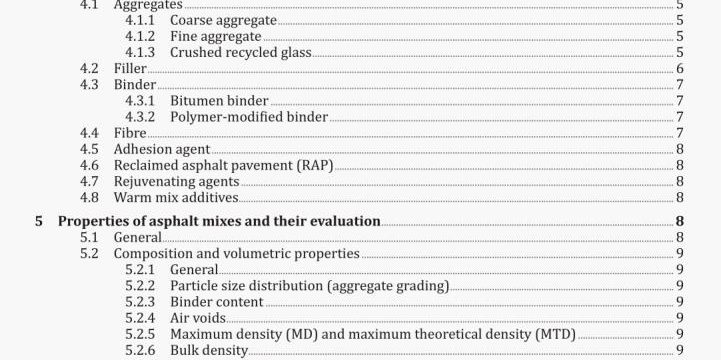AS 2150-2020 pdf download.Asphalt-A guide to good practice.
5.2.8 Voids filled with binder
The voids filled with binder should be determined in accordance with AS/NZS 2891.8.
5.3 Mechanical properties by Marshall method
5.3.1 General
Table 10 gives typical properties and limits for dense asphalt mixes. Mechanical properties of open- graded asphalt are not usually used as a basis for design, as the mechanical properties are not sensitive to variation in binder type or content. Such mixes are usually designed on the basis of composition and volumetric properties only.
5.3.2 Stability
The Marshall stability of compacted mix should be determined In accordance with AS/NZS 2891.5. Table 10 shows minimum limits for stability.
NOTE For determination of stability by the Marshall procedure. 50-blow compactive effort is most commonly used. Where specified for heavy-duty pavements, such as aircraft runways, container terminals, highways, arterial roads In Industrial areas and freeways, 75-blow compactive effort maybe used. For light-duty pavements, 35-blow compactive effort may be used.
5.4 Other properties
For special applications, consideration should be given to specifying the following properties and materials as appropriate:
(a) Stiffness/dejormation resistance — Increased mix stiffness may be required to reduce deflection of thick asphalt pavements or improve deformation resistance of wearing course asphalt. Stiffness is generally increased by —
(i) choice of particle size distribution and air void content;
(ii) use of angular fine aggregate particles;
(iii) higher viscosity binder; and
(iv) use of a specific type of modified binder.
Resilient modulus of asphalt may be determined by the indirect tensile test in accordance with AS/NZS 2891.13.1. Flexural stiffness may also be measured from the test given in AGPT-T274. Ranking of deformation resistance of asphalt mixes may be determined from the wheel tracking test In AGPT-T231.
(e) Permeability — Low permeability is achieved by asphalt having low in-situ air voids. The air voids in the asphalt should be discrete and not interconnected. As well as the design properties of the asphalt, the air voids are also a function of the field compacted density.
(f) Surface texture —Macrotexture, or texture depth, is influenced by choice of nominal size of mix, shape, type and grading of aggregates, and binder content.
(g) Skid resistance — Skid resistance is the frictional resistance provided by the pavement surface to the vehicle tyres during acceleration, braking, or cornering manoeuvres. Skid resistance is a function of both macrotextures and microtextures. Aggregates resistant to polishing may be specified for improved skid resistance at intersections, small radius curves or where the road gradient is steep.
NOTE I Accelerated polishing typically occurs on roads with a high volume of traffic particularly heavy vehicles.
Colour — After a period of time, weathering and traffic will wear the binder from the road surface exposing the natural aggregate colour, Colour effects may be achieved by adding colour pigments to the asphalt during manufacture (proprietary coatings may also be applied to the surface).
NOTE 2 When the coloured binder is worn from the surface of the road, the colour of the aggregate will be shown with the coloured binder remaining in the areas between the large stones. With larger sized asphalt such as 10 mm or greater, the aggregate will occupy the majority of the road surface area and dominate the colour. The best colour lasting performance will be achieved with small-sized asphalt such as 5 mm or 7 mm nominal size.
(I) Resistance to moisture damage — Adhesion agents, such as hydrated lime and chemical additives, may be specified where conditions are such that stripping of aggregate from binder is likely to occur.
Susceptibility of asphalt mixes to moisture damage may be determined In accordance with AGPT-T232. For heavy duty pavements, the test should include one cycle of freeze/thaw conditioning.
(j) Binder drain-oil— Binder drain-off can occur during transport and handling of mixes with high binder film thickness such as open-graded asphalt and stone mastic asphalt. Binder drain-off is minimized by limiting asphalt temperature or use of modified binders, or addition of fibre.
Susceptibility to binder drain-off may be determined in accordance with AGPT-T235.
Susceptibility to attack by fuel and oil — Proprietary coatings that resist attack by fuel and oil may he applied to the surface. Some modified binders also provide improved resistance to fuel and oil damage to the mixture.AS 2150-2020 pdf download.Asphalt-A guide to good practice
Asphalt-A guide to good practice
